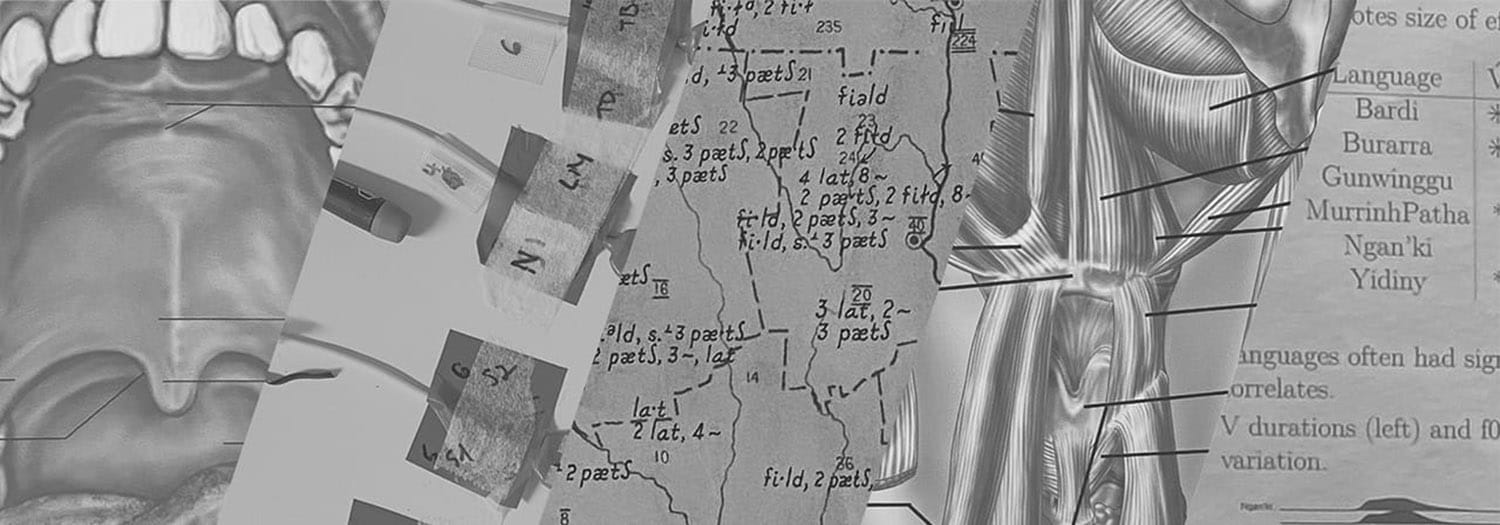Yale presents a strong showing at AMP
Yale- and Haskins Laboratories-affiliated linguists showcased seven different presentations at the Annual Meeting on Phonology (AMP) this weekend—more presentations than any other university.
Haskins Laboratories Senior Scientist Doug Whalen and Tara McAllister of New York University jointly conducted a tutorial session on the use of ultrasound technology for phonetics research. Doug gave an overview of the techniques and methodology available, while Tara showed how they can be applied to the study of language acquisition among individuals with and without speech disorders. These topics were further discussed in a poster with Heather Campbell of New York University.
Ph.D. candidate Rikker Dockum spoke about how the phonology of a language can reveal its history. Historical linguists traditionally find relationships between languages by comparing their sounds and identifying words, called cognates, that might be related to one another. However, previous work in historical linguistics do not consider phonological aspects of language beyond establishing cognacy between words. Rikker’s talk explored the idea that perhaps historical relationships can be discovered by comparing the phonologies of entire languages, not just individual words. By conducting several statistical tests, Rikker found that relationships between languages of the Tai family can be revealed by considering the frequency of individual sounds and sequences of two sounds (bigrams) in each language.
Graduate student Chris Geissler presented a study on koinéization, the process by which new dialects of a language are formed. Specifically, their study focuses on the Tibetan community in the city of Kathmandu, Nepal. According to a theory by Peter Trudgill, koinéization in a new immigrant community involves two steps. In the simplification step, new immigrants fail to transmit certain varieties of the language to their children. Then, in the focusing step, the second generation of the community eventually chooses one variety of the language as their standard. After interviewing seventy-three Tibetan speakers in the city, Chris found that many features of the language were not adopted by second-generation speakers, but that features of more socially prestigious dialects were more likely to be adopted. However, contrary to Trudgill’s theory, second-generation Tibetan speakers in Kathmandu have yet to converge to a standard dialect among themselves.
Graduate student Martín Fuchs presented work on stress assignment in Spanish, a language in which changing the stress could change the meaning of a word. Martín’s project focuses on antepenultimate stress: words, such as metáfora ‘metaphor,’ in which the stress falls on the third-to-last syllable. It has long been known that antepenultimate stress does not occur if the second-to-last syllable is heavy (i.e., it ends with a consonant), or if the last syllable begins with certain consonants, such as rr, ñ, or y. Some believe that this is because a syllable followed by an rr is treated as a heavy syllable even if it does not end with a consonant. Others believe that the pattern is a coincidence of history; Spanish is a descendant of Latin, and these three consonants were originally two consonants, one of which was the end of the third-to-last syllable. To compare these two hypotheses, Martín conducted an experiment in which thirty-one Spanish speakers were asked to rate various words with and without antepenultimate stress. Martín fitted a number of models to the results, the best of which took into account whether the second-to-last syllable was heavy, without considering rr to make the previous syllable heavy.
Graduate student Samuel Andersson showed how language games can be used to investigate the phonology of Swedish. Language games are simple rules for modifying a language; a well-known English language game is Pig Latin. In the Swedish language game rövarspråket, each consonant is duplicated, and an o is inserted in between the two copies. In his study, Samuel shows how several questions in phonology can be addressed by using language games as a tool. One of these questions is that of opacity: whether one phonological process can interfere with another. In Swedish, a short vowel /œ/ can sometimes change to [ɵ] before an /r/. In certain cases, rövarspråket can change a long /œ/ to a short one. For example, the word för ‘for’ is pronounced with a long /œ/, but its rövarspråket version, foföror, is pronounced with a short /œ/ immediately before the /r/. This /œ/ cannot change to [ɵ] to produce [fɔfœˈrɔrː], suggesting that the application of rövarspråket rules prevents the /œ/-to-[ɵ] change from applying.
Finally, Assistant Professor Jason Shaw presented joint work with Shigeto Kawahara of Keio University on how syllables are formed in Japanese. In Japanese, the vowels /i/ and /u/ are not pronounced when they occur between two voiceless consonants. For example, the word shutaisei /ʃutaisei/ ‘subject’ is pronounced as [ʃu̥taisei] or [ʃtaisei]. When this occurs, two consonants now appear adjacent to one another. There is disagreement on whether these two consonants are part of the same syllable, or two different syllables. To investigate this question, Jason and Shigeto conducted a study in which they measured the tongue movements of six Japanese speakers in Tokyo. Using a methodology they presented at the Workshop on Dynamic Modeling, Jason and Shigeto first determined whether the silent vowel was deleted, or whether it was still there but silent. In the latter case, the two consonants are part of separate syllables. In the former case, Jason and Shigeto performed an analysis of articulatory stability. This second analysis also suggested that the two consonants are part of separate syllables, in line with previous phonological arguments to that end.
The titles of the seven presentations were as follows.
- Ultrasound Biofeedback, Doug Whalen and Tara McAllister
- Phylogeny in phonology: How Tai sound systems encode their past, Rikker Dockum
- Phonological koinéization in Kathmandu Tibetan, Christopher Geissler
- On syllable weight and antepenultimate stress in Spanish, Martín Fuchs
- Rorövovarorsospoproråkoketot: Language games and Swedish phonology, Samuel Andersson
- Consequences of high vowel deletion for syllabification in Japanese, Jason Shaw and Shigeto Kawahara
- Quantifying complexity of children’s tongue contours using ultrasound imaging, Heather Campbell, Doug Whalen, and Tara McAllister
AMP was held from September 15 to 17, 2017, at New York University. The full program, including abstracts, is available on the conference website.


